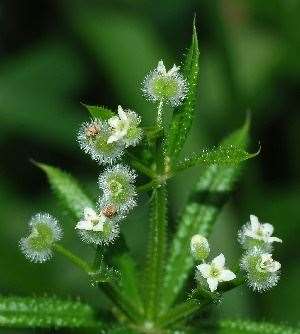Field Guide  Weed Management
Weed Management  Cleavers
Cleavers
Cleavers
Crop Impacts: Spring wheat, winter wheat, durum, barley and oats
 | |
About Cleavers:Cleavers, also commonly known as Goosegrass, have teeth all along and down the stem. These teeth latch on to other plants to help support them, since they can grow very tall, but do not have the stability to support themselves due to lack of strength. Latching on to other plants does not only give cleavers the stability they need, but also helps them retain the nourishment that is needed to sustain growth and existence. Cleavers have very large roots allowing them to survive during dry, or drought conditions. Family: Rubiaceae  
Cleavers Scouting and Prevention:Taking precautions can help avoid the growth of Cleavers within yield crops. Random ground checks of different areas of the field can give notice of whether or not cleavers are growing. If cleavers are found in the early stages, use a herbicide to remove them, cleavers are most sensitive during early growth stages. Cleavers Control:Pre and post season tillage can help. When Pre-seeding, you must seed either earlier or later than usual. Mowing is not effective for Cleaver weeds because of the grow patterns of the weeds. When choosing a herbicide, ensure that it is cleaver free, and when changing fields, ensure that you clean the machinery, to avoid spreading of the cleaver weed. Latin / Alternative Cleavers Names:- - Bedstraw
- - White Hedge
- - Cleaver-wort
- - Cathweed
- - Scarth-grass
- - Grip-grass
Additional Cleavers Resources: |
http://www.natureatcloserange.com/2009/05/cleavers.html Nature at Close Range
http://www.gov.mb.ca/agriculture/crops/weeds/fab06s00.html Manitoba Government: Ag
http://www.precisionpac.com/ Dupont Precision Pac
http://www.weedwreckingcrew.com/ Dupont Weed Wrecking Crew